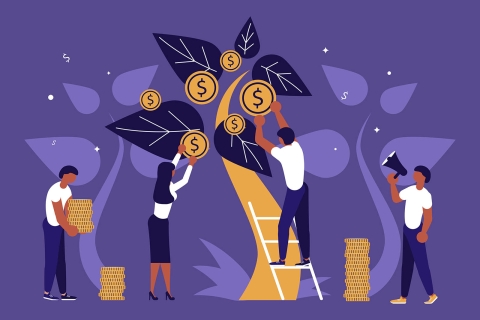Leading the way with a new framework for economic and community development
Author
Upcoming Events
Related News

A new approach to economic and community development is emerging. Instead of being about attracting companies that create jobs over which communities have no control, the emerging paradigm is about connecting the underutilized assets of place with market opportunity to grow assets that are owned and controlled by and for the benefit of low-wealth people and places. Assets include eight distinct forms of wealth - social capital, natural capital, political capital, built capital, individual capital, cultural capital, financial capital and intellectual capital. The healthier the stocks of all these forms of wealth the more robust, resilient, and sustainable the economy.
Today we allow our economy to be based on exploitation of some forms of wealth to create others. For example, many firms sacrifice the well-being of workers through excessive productivity demands, unsafe conditions, and/or capricious scheduling for the sake of accruing financial capital. Products are manufactured using processes and inputs that degrade water quality or other aspects of the natural environment. However, we cannot exploit our way to sustainability. Achieving sustainability will require rethinking not only what we produce, but how we produce it. This imperative offers an opportunity to revalue rural, urban and suburban people and resources and engage them in broader regional economies for mutual benefit by thinking and working with systems, not just individual enterprises.
One mechanism with a proven track record for building an inclusive and more sustainable economy from the ground up is the wealth creation value chain. A wealth creation value chain is a set of relationships among the people and businesses whose skills and contributions are essential to produce and utilize a good and/or service. Wealth creation value chains are driven by the self-interests of producers and buyers and generate financial profits while contributing positively to various stocks of wealth. Wealth creation value chains have demand partners (wholesale buyers that have their fingers on the pulse of consumers), transactional partners (businesses that fulfill the functions required to produce and deliver the good or service), and support partners (organizations that make it possible for transactional partners to do business – think insurance, financing, recruitment and training, etc.). Wealth creation value chains operate within systems that often create bottlenecks (inefficiencies), gaps (missing functions), and underutilized resources. Wealth creation value chains, properly conceived and developed, have the proven potential to change the way business is done from the often wasteful, damaging and exclusive economy we experience today to a “new normal.”
There are many opportunities present in our economy right now to improve economic and community outcomes and reduce dependence on subsidies, but they won’t be realized without leadership. Today in most places it is no one’s job to forge the connections based on identified self-interests that are required to explore, pilot, implement and institutionalize wealth creation value chains. Each organization is more concerned with their individual self-interests than they are in understanding the self-interests of others. Our siloes keep us from the very relationships that can open new opportunities. Wealth creation value chain coordinators are the lynch pins of this work. Coordinators hold the values of the chain, envision and hold the big picture of what the chain can be when it is built to scale, and facilitate its formation and implementation. Coordinators have the courage to go outside their “comfort zones” to understand what’s possible. Sometimes, though not always, the same organization that takes on coordination also serves a function as a transactional partner in the chain. Coordinators can come from the public, private or non-profit sectors, but will only be effective when the leadership of their organization understands that a wealth creation value chain is not a “project” of any single organization; it is a systems change endeavor with shared benefits and shared responsibilities. Coordinators are not single individuals: they are organizations with the capacity to engage more than one staff person in the work.
As Ryan Coffey Hoag, Extension Education at Michigan State University wrote of his experience co-coordinating a wealth creation value chain in the tourism sector, “The wealth creation value chain has been like a shot of adrenalin, fusing traditional economic development with community development, helping us to focus on various forms of community wealth. It has helped us to identify shared values across our region and engage non-traditional stakeholders, which have led to the development of additional chainlets. Our success implementing the wealth creation value chain has led us to integrate its framework into other systems change initiatives across our county, including the delivery of economic development services. This approach has helped us capitalize on the various forms of wealth across our region while empowering non-traditional stakeholders throughout the process.”
County leadership can be instrumental in adopting the wealth creation framework and providing training and encouragement for wealth creation value chain coordinators in multiple sectors. NACo can be a terrific vehicle for shared learning across the country that will allow us to accelerate the transformation toward a more equitable and sustainable future.

Attachments
Related News

Congress introduces Bipartisan HOME Reform Act
On October 21, 2025, Reps. Mike Flood (R-NE.) and Emanuel Cleaver (D-MO.) introduced the HOME Reform Act, which would make substantial changes to the eligible uses and exemptions applying to the Home Investment Partnerships (HOME) Program.

County program helps boost foster youth into adulthood
A Los Angeles County guaranteed income program, dubbed “BREATHE,” is helping set up low-income residents — including more than 2,000 foster youth aging out of care — for success by providing them with monthly payments, no strings attached.

Bridging the digital divide in Telfair County, Ga.
In rural Georgia, Telfair County is taking meaningful steps toward expanding broadband access as a strategic lever for economic mobility.
